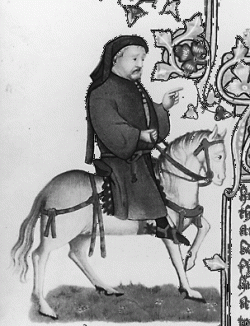Lesson Plan III
As well as the other lesson plans, this lesson plan on Chaucer can also benefit student learning. This lesson plan is designed so that the students will make the connection between the past and the present. Mostly, when students read Chaucer, they are bored with the idea of the medieval setting, but this lesson plan will allow them to see that these stories can be interpreted into things that they could possibly encounter everyday. This is important to teach so that students learn to relate stories they read to their everyday lives.
Chaucer vs. Today
The Objective
Students should read The Miller's Tale and come to class prepared to discuss it. After asking students what they thought of it, ask them to think of things that it could portray in today's society. The objective is for them to realize that these stories can be related to what happens in today's society. It's important that they can understand the text and know how to give other examples of this.
The Process
Start by asking the students if they have watched Jerry Springer. If many hands go up, then ask them to share these stories. Then, tell them it is just like The Miller's Tale.
Then proceed to tell them the tale in the sort of slang you hear on Jerry Springer. From there, you should have them write out their own interpretation of another Canterbury Tale told in the same style of words and Jerry Springer.
A High School literature teacher, Jessica Beagan's interpretation of The Miller's Tale is one great example of how the story can be told:
"In a nutshell, the story is about this man named John, a
carpenter about 40 years old. He is married to a lively young
girl named Alison who is actually in love with a young student
at Oxford named Nicholas. The young lovers scheme to get rid
of the husband by telling him that a flood worse than Noah's
is coming and that he must find three bathtubs and rig them
up to the barn so that they will be above the water line.
When the flood comes, they will cut the ropes and float off
on the water when Nicholas gives the signal that the flood is
on it's way. So John gets all ready and the three each get
into their tubs and wait. Well, John falls asleep so Nicholas
and Alison sneak off for a tryst.
Meanwhile, the town priest Absalom, also in love with Alison,
decides that he's going to make his move with John out of the
picture and calls up to the room where Nicholas and Alison are for a kiss.
Alison tries to get him to leave, but when he won't till he gets a kiss,
she sticks her rear end out the window. Absalom kisses her heartily, but
quickly realizes he's been duped. In a rage, he goes to a
blacksmith for a hot poker and returns to the window, asking for
another kiss. This time, Nicholas sticks his bum out the window
and gets the poker jabbed at him. Absalom feels quite vindicated
and Nicholas is screaming in pain crying out for water. John
hears Nicholas hollering and wakes up thinking Nicholas sees the
flood and he cuts the lines on the tub and crashes to the ground,
a sack of broken bones."
The final product should include the following:
After reading the story, the students should then conduct their own story. After reading one of the other tales, they should try to put it in their own words. Typed and printed with the original version along with their own version.
When the students are finished and are ready to turn in their products, it would be optional to present their interpretations to their peers for extra credit points. This will give them a chance to use their imagination and well give them an opportunity to present their story in a comical manner.
Grading Rubric
The grading is a little different than the other two lessons. Understanding of the concept will come strictly from how well their writing is. If a student looks like he or she didn't put in a lot of effort in trying to understand the tale they chose, their grade will reflect that.
It's difficult to grade these type of assignments, but it's important that the students show they understand how Chaucer can be interpreted in today's society.

